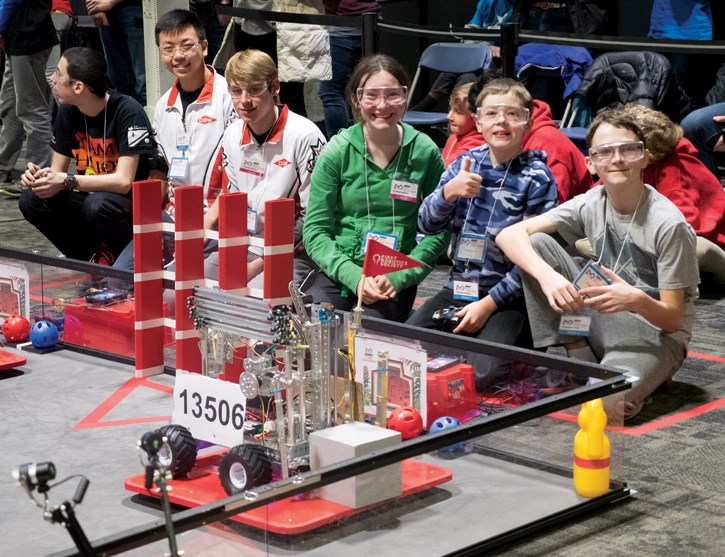Canmore might be known for its high caliber athletes, but don’t let that distract you from what’s going on at Our Lady of the Snows Catholic Academy.
Late last month a group of seven students with the school’s robotic club took second place at the First Tech Challenge of Alberta (FTC) held at the Telus World of Science in Edmonton.
The two-day robotic competition included 33 teams from schools across the province, each vying to score as many points as possible through five qualifying rounds.
For the club, which began in September, placing second was a huge accomplishment.
“I’m pretty proud with how well we did,” said Tobias Tomana, a Grade 7 student who was responsible for physically building the team’s robot.
“We bought the beginner kit, which gave us basic equipment to build a robot, but then we bought some other parts from different websites to complete the robot.”
He said the biggest challenge with building it was remaining focused on the task.
“When you think of robots, it’s cool and you’re really energetic and passionate about it, but when you actually settle down and start thinking about it, you need to calm down and focus.”
Thomas Paul, a Grade 7 student with the club, said it was the first time he had ever been to a provincial competition.
“I thought it was a very exciting experience because it was the very first time I’ve ever been to a provincial competition in anything,” said Paul, who wants to become a robotics engineer and work on the International Space Station.
“I’ve always been fascinated by the fact that you can make a piece of machinery out of metal, make it do what you tell it to do, and make it able to be controlled under your command.”
Oliver Langhorst, a Grade 7 student who was responsible for coding the robot, said they all learned a lot.
“We all came into this unprepared. I know a couple of us had some experience, but none of us had really built a robot before so we had a lot of problems, but we learned from fixing those,” said Langhorst.
To participate in the competition the team had to build a metal robot that could fit inside an 18-inch sizing cube. Once the competition started, the robot was allowed to expand.
Each match included four randomly selected teams with two teams per alliance.
During the competition, each team had to select two drivers and a coach to operate their robot. A team’s alliance partner in one match could also become their opponent in another match.
Working with their alliance partner, each match was played in a 12-foot square arena with a foam tile floor and foot high walls.
The goal of each match, which began with a 30 second autonomous period followed by a two minute driver control period, was to score as many points as possible.
To score points each team had to use its robot to pick up and place six-inch foam blocks called glyphs in a cryptobox following a cypher (code). If a team completed a cryptobox cypher it had the opportunity to move a relic (small figure) into the recovery zone located outside the perimeter wall to score additional points.
Teams could also score additional points by completing other tasks, such as balancing on a platform mounted to the floor at the end of each match.
“We weren’t really fast at picking up glyphs so we picked teams that could do that,” said Langhorst, who also hopes to one day become an engineer.
“Our strength was getting the relic into the third zone,” said Langhorst, explaining the robot had to pick it up and extend its arm past the perimeter wall.
“There’s three zones each going further and further, so the further you get it, the more points it’s worth.”
He said the team’s biggest weakness was turning because of the robot’s large wheels.
“They kind of gripped too much, making turning very slow.”
Luc Arvisais, a math teacher at the school, said he was pleasantly surprised by the team’s results.
“It’s given students a push to continue for next year,” said Arvisais.
Richard Berry, a father with a background in flight simulation for remotely operated vehicles, offered to help the club when his daughter told him about it.
“We started at the end of September, with no equipment, but we got $2,000 from a donor and the school council gave us $1,500, so we bought quite a bit of equipment from that,” said Berry.
Reflecting on the competition, Langhurst said he was grateful for the opportunity.
“It’s just a fun activity to do after school that you don’t really have many opportunities to do otherwise,” Langhorst. “You can buy a volleyball and just practice at home, but for robotics it’s kind of hard to do it on your own and it’s quite expensive, so if you have a team it’s easier.”




